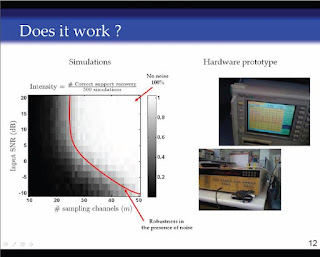
While 2008 is about to shut down, I wanted to say thank you for your help. For the past two years, an increasing number of people have contributed to this blog. Direct contributors have included:
and enriched it wonderfully. Some of them even created their own research blog, this is outstanding!
Since I am slow, my understanding of some of the CS papers or some subject areas could not have occured were it not for a kind person to answer it. I got lucky often and most of the time, an e-mail conversation ensued that I eventually felt was important for everybody else to read. The following people kindly ok'ed our offline discussions into a full post or some part of it:
- Arkadi Nemirovski
- Piotr Indyk
- Alexandre d'Aspremont
- Anna Gilbert
- Gerry Skinner
- Ramesh Raskar
- Jon Dattorro
- Ashwin Wagadarikar
- Justin Romberg
- Richard Baraniuk
- Roummel Marcia
- Rebecca Willett
- Radu Berinde
- Raghu Kainkaryam
- Emmanuel Candes
- Dror Baron
- Paul O'Grady
- Michael Friedlander
- Ewout Van Den Berg
- Thong Do
- Joel Tropp
- Weiyu Xu
- Yin Zhang
- Gabriel Peyre
- Remi Gribonval
Thank you!
As a matter of general policy, if you are having a detailed technical e-mail discussion with me, I generally ask if it's OK to publish it afterwards. I usually go through some proof-reading and remove non technical items. Eventually the final draft is OK'ed by you.
One of the annoying thing that occurs when I go to conferences is that I also bring a bunch of folks who will relentlessly ask questions. Thank you to Ron DeVore, Jean-Luc Germond and Bojan Popov for allowing us to disrupt their smooth meeting at Texas A&M. The same goes to Frank Nielsen for ECTV '08.
Much of the referal traffic to this blog was not self generated! Terry Tao's, Andrew Gelman's and John Langford's blogs provide much of that traffic. Thank you guys.
While I see less of this nowadays, I still feel strongly that as the author of your own paper, you should go through the pain of building a website which can take about 5 minutes using Google Sites these days. If you go through the effort of giving additional online information or adding your code, I generally try to make sure you have the maximum exposure as a result. I always prefer reproducible research results to hard to reproduce papers. Please also consider that even if an algorithm looks easy for you to implement, it may not be the case for most. In particular I intend on remaining slow and dumb for the continuing year (no good resolution for 2009 on that front).
I also say it is a pain for you to have a greater web presence because most of you are currently not being judged by your peers on these "details". You eventually will! if not by your peers, you will by the engineers in companies that want to do business with you either as a future employee or a consultant. There is no better time to start than today.
Recently, I had a discussion with one of you on the non-availability of the preprints on his site. The e-mail discussion that ensued revealed that the lab policy had not be updated in a long time. The folks at Sherpa provide you with a database for checking on your ability to perform self-archiving with specific publisher's copyright policies. Please use this tool as opposed to relying on an outdated policies or information.
As an aside, if you believe this blog provides a valuable utility consider donating to the webcrawler engine that makes it all possible at watchthatpage. If you are using this service for other purposes please consider donating money to them as well. The paypal system accepts credit cards and additional information can be added in a message form where you might want to let them know about their huge contribution to the Nuit Blanche blog. The kids implementing this tool told me that it is a typical start-up with two guys working in a dorm. Again, this blog and the community of readers would not be what it is without them, please sparse a buck or twenty or a hundred, for some of you think of it as just a business expense. I do not own stock in that venture.
Last but not least, the folks behind the codes and websites providing a resource to the CS community should be commended for doing an extraodinary job. They are listed in the Compressive Sensing 2.0 page. In particular, a big kudos goes to Mark Davenport for attending and regularly updating the Rice Compressive Sensing site.
To the ones I forgot to list, please forgive me and do tell me. To all, thank you and Happy New Year. Enjoy watching the finale of Sidney's fireworks.

















